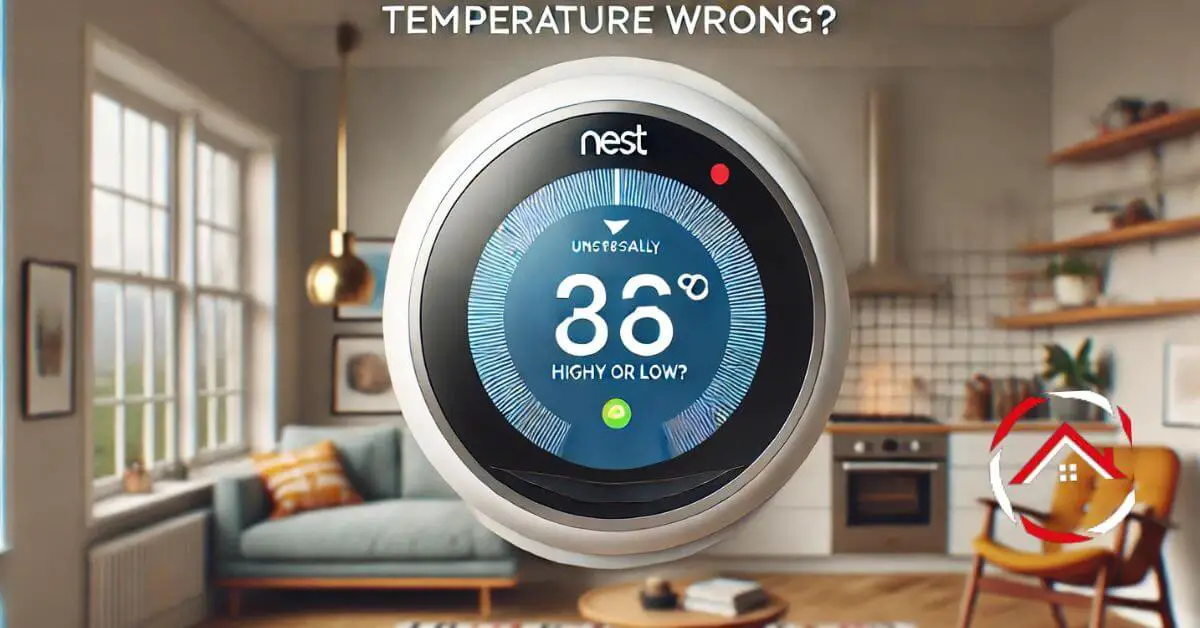Is your Nest thermostat giving you trouble with incorrect temperatures? You’re not alone. Many people face this frustrating issue.
Imagine waking up to a freezing home or coming back to a sweltering room. It’s not just inconvenient; it can affect your comfort and energy bills.
But don’t worry. This guide will help you figure out why your Nest thermostat wrong and how to fix it.
Let’s dive in and get your home feeling just right again.
Table of Contents
Why Is My Nest Thermostat Temperature Wrong?
Have you ever wondered why your Nest thermostat seems to misread the temperature? It can be a perplexing issue, especially when you’re trying to stay comfortable. Understanding the possible reasons behind this problem can help you find a quick solution.
1. Incorrect Calibration
Your Nest thermostat might need recalibration. If the temperature readings are consistently off, it might not be measuring accurately.
2. Placement Issues
The location of your thermostat can affect its readings. If it’s near a heat source or in direct sunlight, it may not reflect the true room temperature.
3. Faulty Sensors
Sometimes, the sensors inside your thermostat can malfunction. This can lead to incorrect temperature readings and impact your home’s climate control.
4. Software Glitches
A software update or glitch can cause inaccuracies in temperature readings. Checking for updates or restarting your thermostat might resolve the issue.
5. Wiring Problems
Loose or damaged wires can lead to incorrect temperature readings. Ensuring that all connections are secure can help maintain accurate measurements.

How To Calibrate Nest Thermostat?
If your Nest thermostat isn’t showing the right temperature, calibration might be the solution. Follow these simple steps to ensure your thermostat reads accurately and keeps your home comfortable.
- Check Temperature Settings: Ensure your thermostat is set to the correct mode (heating or cooling) and verify the temperature settings.
- Use a Separate Thermometer: Place a separate, reliable thermometer near your Nest thermostat to compare readings.
- Adjust Calibration: On your Nest app or thermostat settings, navigate to the calibration option and adjust the temperature based on your thermometer’s readings.
- Wait and Test: After adjusting, wait for the thermostat to stabilize and then check the temperature again to ensure accuracy.
- Restart Thermostat: If calibration doesn’t seem to fix the issue, try restarting your thermostat to refresh its settings and recalibrate.
Why Is My Nest Ambient Temperature Wrong?
Noticed that your Nest thermostat’s ambient temperature reading seems off? This issue can disrupt your home’s comfort and energy efficiency. Let’s explore the potential reasons behind these inaccurate readings and how to address them.
1. Thermostat Placement
The placement of your Nest thermostat can greatly affect its readings. If it’s near drafts, direct sunlight, or heat sources, it may not accurately reflect the room’s true ambient temperature.
2. Sensor Obstructions
Objects or furniture blocking the thermostat can interfere with its sensors. Make sure there’s nothing obstructing the air around your Nest to ensure accurate readings.
3. Airflow Problems
Poor airflow around your thermostat can lead to incorrect temperature readings. Check for issues with your HVAC system or vents that might affect air circulation.
4. Calibration Issues
Your Nest thermostat might need recalibration to correct ambient temperature readings. Regularly checking and adjusting calibration settings can help maintain accuracy.
5. Software or Firmware Bugs
Occasionally, software or firmware bugs can cause incorrect temperature readings. Ensure your Nest thermostat’s software is up-to-date and consider restarting the device if you encounter problems.
How To Fix Nest Thermostat Temperature Wrong?
Dealing with incorrect temperature readings on your Nest thermostat can be frustrating. Luckily, there are straightforward steps you can take to resolve the issue and get your thermostat back to accurately managing your home’s climate.
- Check Calibration Settings: Verify and adjust the calibration settings in the Nest app or on the thermostat itself to correct any discrepancies.
- Verify Placement: Ensure the thermostat is installed in an ideal location, away from heat sources, direct sunlight, and drafts to get accurate readings.
- Inspect Wiring: Examine the thermostat’s wiring for any loose or damaged connections that might affect temperature accuracy and secure any issues.
- Update Software: Make sure your thermostat’s software is up-to-date, as outdated firmware can cause inaccuracies. Update through the Nest app if needed.
- Restart Device: Restart your Nest thermostat to refresh its system and settings, which can help resolve minor glitches affecting temperature readings.
Why Is My Nest Thermostat Reading Too Low?
If your Nest thermostat consistently shows a temperature that’s too low, it can lead to discomfort and inefficiencies in your home. Understanding the possible causes behind this issue can help you address it effectively and ensure your home stays at the right temperature.
1. Improper Thermostat Placement
Your thermostat’s location plays a crucial role in its temperature readings. If it’s near a cold draft or in an area with poor airflow, it may inaccurately register a lower temperature.
2. Faulty Temperature Sensors
Malfunctioning sensors inside your Nest thermostat can result in incorrect temperature readings. A sensor issue can cause your thermostat to display a temperature that’s lower than the actual room temperature.
3. Calibration Errors
Calibration settings might be off, leading to incorrect low temperature readings. Regularly recalibrating your thermostat can help ensure accurate temperature displays.
4. Drafts or Airflow Issues
Cold drafts from windows, doors, or vents can affect your thermostat’s readings. Ensuring proper insulation and checking for airflow obstructions can prevent inaccurate low temperature readings.
5. Software Glitches
Occasional software glitches or bugs can cause your thermostat to display incorrect temperatures. Checking for software updates and restarting the device can help fix these issues.
How Do I Adjust My Nest Temperature Sensor?
Adjusting your Nest temperature sensor can help ensure accurate temperature readings and maintain a comfortable environment. If you’ve noticed discrepancies in temperature readings, these simple steps can help you calibrate and adjust your sensor effectively.
- Access Sensor Settings: Open the Nest app, go to the settings for your temperature sensor, and select the calibration or adjustment option.
- Compare with a Separate Thermometer: Use a reliable thermometer to check the current room temperature and compare it with your Nest sensor’s reading.
- Adjust Calibration: Enter the temperature reading from your thermometer into the Nest app or on the thermostat to adjust the sensor’s calibration accordingly.
- Check Placement: Ensure the sensor is placed in a location with good airflow and away from drafts or heat sources to improve accuracy.
- Test and Monitor: After making adjustments, monitor the sensor’s performance to ensure it now provides accurate readings and make further adjustments if necessary.
Wrap Up
Dealing with a Nest thermostat that shows the wrong temperature can be frustrating, but fixing it is often straightforward.
By checking calibration, placement, and connections, you can solve most issues. Regular updates and maintenance help keep your thermostat accurate.
If you follow these steps, you’ll enjoy a comfortable home environment without constant adjustments to home security gadgets.
Remember, a well-calibrated thermostat not only improves comfort but also saves on energy costs.
So, take a little time to troubleshoot and adjust your Nest, and you’ll be back to perfect temperatures in no time.
Frequently Asked Questions
Why is my Nest thermostat showing the wrong temperature?
If your Nest thermostat shows the wrong temperature, it could be due to inaccurate sensor placement, a malfunctioning thermostat, or issues with the HVAC system. Ensure the thermostat is installed in an appropriate location and check for any software updates or calibration settings.
How can I fix inaccurate temperature readings on my Nest thermostat?
To fix inaccurate temperature readings on your Nest thermostat, try recalibrating it through the settings menu, ensuring it is installed away from direct sunlight and drafts, and verifying that the sensor is clean and unobstructed. Consider restarting the device if problems persist.
What should I do if my Nest thermostat is not heating or cooling properly?
If your Nest thermostat is not heating or cooling properly, check the wiring connections and ensure they are secure. Verify that the HVAC system is functioning correctly and that the thermostat is set to the right mode. Consider resetting the thermostat if issues continue.
How do I reset my Nest thermostat to fix temperature issues?
To reset your Nest thermostat, go to the settings menu, select “Reset,” and choose “All Settings” to restore factory defaults. This can resolve temperature issues caused by incorrect configurations. After resetting, you may need to reconfigure your preferences and settings.
References:
Support.Google.Com. Why your Nest thermostat temperature and your home temperature can be different? https://support.google.com/googlenest/answer/9233450?hl=en-SG#:~:text=It’s%20normal%20for%20your%20home’s,%2C%20differential%2C%20or%20temperature%20swing.


